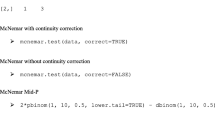Abstract
The first contribution of this paper is to demonstrate that the paired-comparison model may be derived from a variety of different initial assumptions about the nature of paired comparisons, some of these assumptions appearing to the author to be more appropriate to a description of the preference-decision process than others. The second contribution of this paper is to note that the generalization of the model to triple comparisons chosen earlier is not the one compatible with the Lehmann model even though it possesses other desirable properties. Limited numerical calculations suggest that both models for triple comparisons give comparable results in applications. Their asymptotic properties should be similar.
Similar content being viewed by others
References
Bradley, R. A. and Terry, M. E. Rank analysis of incomplete block designs. I. The method of paired comparisons.Biometrika, 1952,39, 324–345.
Bradley, R. A. Some statistical methods in taste testing and quality evaluation.Biometrics, 1953,9, 22–38.
Kendall, M. G. A new measure of rank correlation.Biometrika, 1938,30, 81–93.
Lehmann, E. L. The power of rank tests.Ann. math. Statist., 1953,24, 23–43.
Luce, R. D.Individual choice behavior. New York: Wiley, 1959. Chap. 1.
Pendergrass, R. N. and Bradley, R. A. Ranking in triple comparisons. In I. Olkin and others (Eds.),Contributions to probability and statistics. Stanford, Calif.: Stanford Univ. Press, 1960. Pp. 331–351.
Savage, I. R. Contributions to the theory of rank order statistics—the two-sample case.Ann. math. Statist., 1956,27, 580–615.
Thompson, W. A., Jr. Characterization of the Bradley-Terry model. Florida State Univ. Statistics Report (mimeo.).
Wilcoxon, F., Rhodes, L. J., and Bradley, R. A. Two sequential two-sample grouped rank tests with application to screening experiments.Biometrics, 1963,19, 385–397.
Author information
Authors and Affiliations
Additional information
Research supported by the Office of Naval Research contract number Nonr-988108, Task Order NR042-004. Reproduction in whole or in part is permitted for any purpose of the United States Government.
Rights and permissions
About this article
Cite this article
Bradley, R.A. Another interpretation of a model for paired comparisons. Psychometrika 30, 315–318 (1965). https://doi.org/10.1007/BF02289494
Received:
Revised:
Issue Date:
DOI: https://doi.org/10.1007/BF02289494




